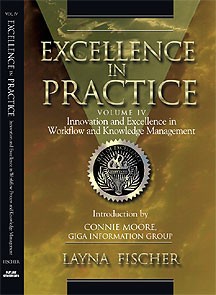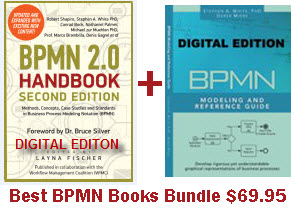Excellence
in Practice, Volume IV
Innovation and Excellence in Workflow and
Knowledge Management
|
|
Published OCTOBER 2000
Author: Layna Fischer
ISBN
0-9640233-9-3
Pages: 280
Price: US $50.00
Size: 7" x 10"
Quality
hardcover. Illustrations, charts, references, appendices, bibliography,
index.
ORDER
FORM |

|
The
criteria for the case studies in this book:
Each case study received a prestigious Excellence in Workflow Award
based on the the following:
-
Innovation
encompasses
the innovative use of technology for strategic business objectives; the
complexity of the underlying business process and IT architecture; the
creative and successful deployment of advanced workflow and imaging
concepts; and process innovations through business process reengineering
and/or continuous improvements.
-
Hallmarks
of a successful implementation
include extensive user and line management involvement in the project while
successfully managing change during the implementation process. Factors
impacting the level of difficulty in achieving a successful implementation
include the system complexity; integration with other advanced technologies;
and the scope and scale of the implementation (e.g. size, geography,
inter-company processes).
-
Impact
is the bottom line, answering the question “what benefits does workflow deliver to the business?” Examples of potential benefits include:
productivity improvements; cost savings; increased revenues; product
enhancements; improved customer service; improved quality; strategic impact
to the organization’s mission; enabling culture change; and—most
importantly—changing the company’s competitive position in the market.
The visionary focus is now toward strategic benefits, in contrast to
marginal cost savings and productivity enhancements.
Readers
of these detailed case studies can find out more about:
-
Their
system application, what the system is used for, who are the users and what
the job entails
-
What
were their key motivations
-
Their
system configuration (number, and type of software, servers, scanners,
printers, storage devices, etc., including the identities of the vendors and
integrators involved)
-
The
number of users currently on the system and number of users planned.
-
How
the company has been impacted by their new system; cost savings, ROI and
increased productivity improvements, competitive advantage gained, and how
they managed to move the goal posts for their industry.
-
Their
implementation process and methodology, the project team, and the change
management and business process reengineering issues they addressed.
-
How
these companies managed both their overall technological and business
innovations.
Table
of Contents
- Bull Worldwide Information Systems (Echirolles, France) Finalist,
Workflow
- Burlington Insurance Group/IFG Companies (Burlington, NC)
Finalist, Workflow
- Convergys (Cincinnati, OH) Finalist, Workflow
- Fast Forward (Johannesburg, South Africa) Silver
Workflow Award
- IBM (Somers, NY) Silver Knowledge Management Award
- Irish Permanent (Dublin, Ireland) Finalist, Workflow
- J. Sainsbury (London, United Kingdom) Finalist,
Workflow
- La Poste (Paris, France) Gold Workflow Award
- Lewisham (Catford, England) Finalist, Workflow
- Lubrizol (Wickliffe, OH) Silver Workflow Award
- Olgivy & Mather (New York, NY) Finalist, Knowledge
Management
- Phillips Fox (Sydney, Australia) Gold Knowledge
Management Award
- Prudential Real Estate and Relocation (Irvine, CA) Gold
Workflow Award
- Saambou (Pretoria, South Africa) Gold Workflow Award
- Sprint (Overland Park, KS) Finalist, Knowledge
Management
Guest
Chapters
- Introduction: Workflow
Goes Mainstream
Connie Moore,
Giga Information Group, with Contributing Analyst, Mike Gilpin
Because application or business integration
solutions are often driven by business initiatives like e-commerce or
supply chain management, economic impact from their use is often
compelling. The choices come down to which solution offers the fastest
time to market while providing robust infrastructure that can support
required service levels and keeps cost of ownership to a bearable level.
This chapter examines the current state of the market, providing a road
map for understanding which solutions are best suited to different
integration scenarios.
- Three Years of Workflow
Technology Evolution
Martin Ader, Principal of
Workflow & Groupware Strategies, France, and author of the highly
acclaimed Comparative Analysis of Workflow Products, looks at how Workflow
technology is now taking full benefits of EAI middleware for application
integration. It is available as object components for tighter integration.
And finally document management is better supported under a portal
approach umbrella. Workflow products now efficiently combine database,
client/server, distribution, visual programming, scripting, home and
mobile work, HTML support, advanced user interface techniques, and
application integration from legacy systems to document management.
- The Workflow Market: A
Global Perspective for 2000
Priscilla Emery, Senior Vice President, Association for Information and Image Management
International (AIIM),
presents some of the results of AIIM’s annual worldwide study to provide
a status of the document technologies marketplace, from both a user and a
supplier perspective. In
2000, AIIM published detailed research into the Workflow market based on a
survey conducted by GartnerGroup. The
resulting information can provide insight on a global perspective based on
the growth and uptake of the workflow market by understanding where
workflow is being implemented and user perceptions on why and how they buy
workflow products.
- Embedded vs. Autonomous
Workflow—Putting Paradigms into Perspective
Michael zur Muehlen,
University of Muenster, Germany and Rob Allen Open Image Systems, Inc.
United Kingdom
Workflow is the automation of a business process,
in whole or in part, during which documents, information, or tasks are
passed from one participant to another for action, according to a software
representation of the process logic, the workflow model. With the advent
of new requirements for workflow engines to inter-operate for tasks such
as Supply Chain Management, it is important for the market to be able to
distinguish between inaccessible rules-based application components, and
workflow engines, be they embedded or not. This paper distinguishes, at a
high level, the differences between the architectures of workflow
management system. Its main function is to clarify the segmentation
between autonomous and embedded workflow deployments.
- Workflow—The "Missing Link" In E-Commerce
Jon Pyke, CTO Staffware Plc
and Chair, Workflow Management Coaltion
Companies across the globe are spending millions on developing
eCommerce projects and many of them have found that their initial
objectives of reducing costs while increasing productivity have not been
achieved. This is often because process automation is either not in place,
or does not run through the entire line of necessary actions required in
order to fulfill an operational request. Quite simply, workflow automates
the procedures within an organization. Mr. Pyke explains how workflow
software adds control mechanisms to the existing system to ensure that the
appropriate tasks are handled at the right time, by the right person and
in the right order. In addition to its task management role, workflow also
facilitates gathering of information and improved data flow, which
benefits users throughout the organization.
ORDER
FORM
About
the Author:
Layna Fischer is author of
highly acclaimed of the Excellence
in Practice Series and editor of the best-selling series New
Tools for New Times.
She is also chair of WARIA, the Workflow And Reengineering International
Association and General Manager of the Workflow Management Coalition
(WfMC).
Ms. Fischer was a senior editor of a leading computer publication for four years
and has been involved in international computer journalism and publishing for
over 15 years.
email: layna@waria.com
ORDER
A REVIEW COPY: (for bone fide book reviewers or members of the press)
Send
this request by mail, fax or email to:
Claire Busch, Future Strategies Inc., (Book Division)
2436 N. Federal Highway #374, Lighthouse Point, FL 33064.
Tel: 954-782-3376. Fax 954-782-6365
Email: awards@waria.com
|


